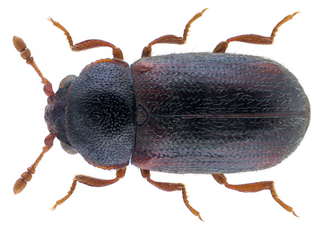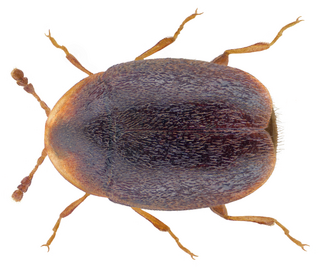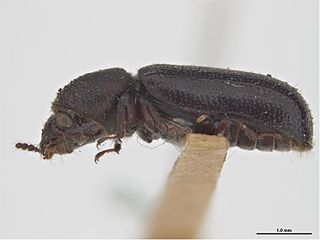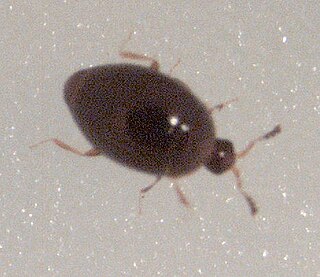
Sphindidae is a family of beetles, in the suborder Polyphaga. They are called slime mold beetles due to their exclusive feeding on slime molds during adult and larval stages, other aspects of their life history are obscure. Palaeontological discoveries since 2015 have added to the geologic history of Sphindidae, including the discovery of Libanopsis, placed in the extinct subfamily Libanopsinae.

Languria is a genus of lizard beetles in the family Erotylidae. There are about 18 described species in Languria.

Lichenophanes is a genus of horned powder-post beetles in the family Bostrichidae. There are more than 40 described species in Lichenophanes.
Aphorista is a genus of handsome fungus beetles in the family Endomychidae. There are at least four described species in Aphorista.

Loberus is a genus of pleasing fungus beetles in the family Erotylidae. There are about 16 described species in Loberus.
Odontosphindus is a genus of cryptic slime mold beetles in the family Sphindidae. There are at least three described species in Odontosphindus.

Clypastraea is a genus of minute hooded beetles in the family Corylophidae. There are more than 20 described species in Clypastraea.

Arthrolips is a genus of minute hooded beetles in the family Corylophidae. There are more than 20 described species in Arthrolips.

Sericoderus is a genus of minute hooded beetles in the family Corylophidae. There are about 12 described species in Sericoderus.

Stephanopachys is a genus of horned powder-post beetles in the family Bostrichidae. There are more than 20 described species in Stephanopachys.
Aenigmaticum is a genus of minute hooded beetles in the family Corylophidae. There are about five described species in Aenigmaticum.
Helesius is a genus of lady beetles in the family Coccinellidae. There are at least two described species in Helesius.

Sphindus americanus is a species of cryptic slime mold beetle in the family Sphindidae. It is found in North America.
Microweisea is a genus of minute lady beetles in the family Coccinellidae. There are about six described species in Microweisea.
Rypobius is a genus of minute hooded beetles in the family Corylophidae. There are about five described species in Rypobius.
Eurysphindus hirtus is a species of cryptic slime mold beetle in the family Sphindidae. It is found in North America.
Eurysphindus is a genus of cryptic slime mold beetles in the family Sphindidae. There are about eight described species in Eurysphindus.

Dacne is a genus of pleasing fungus beetles in the family Erotylidae. There are about 19 described species in Dacne.
Eurysphindus comatulus is a species of cryptic slime mold beetle in the family Sphindidae. It is found in North America.

Orthoperus is a genus of minute hooded beetles in the family Corylophidae. There are more than 20 described species in Orthoperus.












